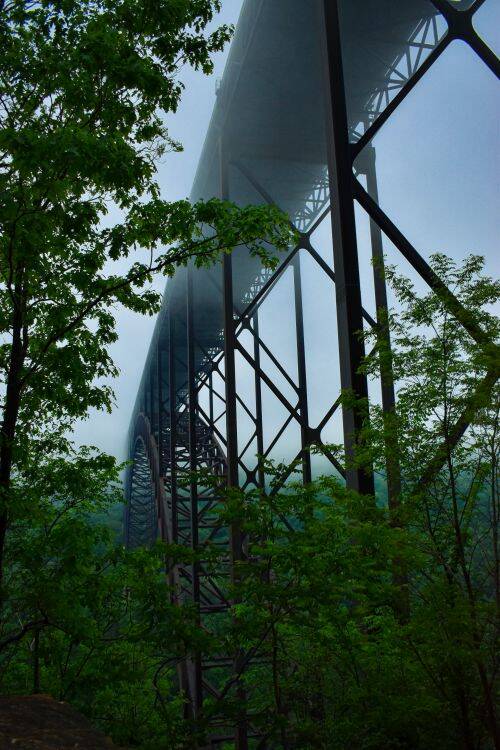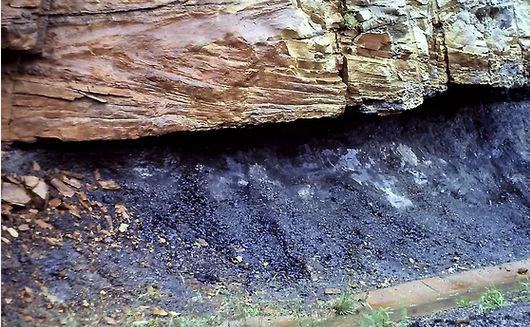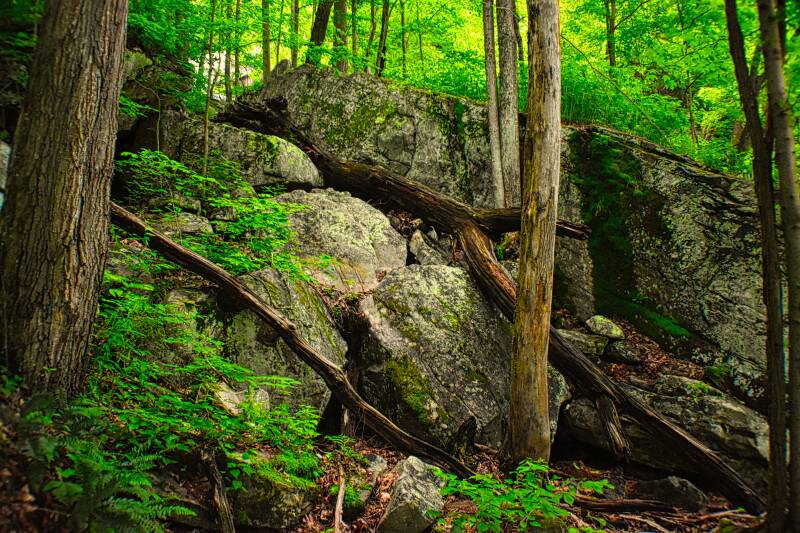photo source by author
!!!! Please understand that our website is still under construction, please keep checking back!!!
Heritage Lost, The New River Gorge
The New River begins its the long, 320 mile journey northward, starting near Blowing Rock, North Carolina, near the Tenneessee border. It snakes its way through three states until it merges with the Gauley River, in the town of Gauley Bridge to form the Kanawha River.
The New River, despite its unique name is quite possibly one of the oldest rivers in the world. It is actually suppose to be the second oldest river on planet earth. Quite honestly, not being cruel to the MIssissippi River, it could very well be the river called, "Old Man River", with a theoretical age of, between 10 to 360 million years old. Not bad for a north flowing river to add as well ! But nowhere in its long trek has it carved such incredible magnificence as it has through Raleigh and Fayette Counties in southern West Virginia.
The New River Gorge area, now the United States newest Federal Park and Reserve, is home to some of the most spectacular whitewater rafting and kayaking east of the MIssissippi. Its unique and amazing wildlife scenery astounds nearly one million visitors each year. Whether in the summer or winter, it offers some of the best whitewater rafting in the east, second only to "Gauley Days" on the Gauley River. During the months of September to October, when water is released for winter pool levels on Summersville Dam, which now has become West Virginia's newest state park.
Wildlife abounds as well as natural pristine forest all shrouded by a large canyon rim that the exact origins remain a hot topic of geologist to this day. Was the canyon always a part of the rivers scenery or was it carved by glacial flows millions of years ago during the last ice age. No one truly knows. But what is known is the fact that it is here in southern West Virginia, that this one particularly beautiful feature of the old river is truly unique.
On November 10, 1978, then President Jimmy Carter signed legislation establishing the New River Gorge as a part of the national park system "for the purpose of conserving and interpreting outstanding natural, scenic, and historic values and objects in and around the New River Gorge and preserving as a free-flowing stream an important segment of the New River in West Virginia for the benefit and enjoyment of present and future generations." In 2019, legislation was written that would allow the park service to buy and maintain more land along the current 65,000 acres set aside by President Carter. The park would consist of just over 7,000 acres at its widest center, the part of the New River Gorge where, from rim to rim, is almost a mile wide and spanned by the and gained even more notoriety with the completion on October 22, 1977, of the New River Gorge Bridge, the longest steel arch span in the Western Hemisphere and the third-highest bridge in the United States.

The New River Gorge Bridge is a steel arch bridge that is 3,030 feet long over the New River Gorge along US route 19 near Fayetteville in Fayette County, West Virginia. With an arch 1,700 feet long, the New River Gorge Bridge was the world's longest single-span arch bridge for 26 years, it is now the fifth longest steal arch span. The highway of the New River Gorge Bridge is an estimated 876 feet above the New River, giving it the bragging rights as one of the highest vehicular bridges in the world. It is currently the third highest in the United States. (2021 Wikipedia) When completed in 1977, it was the world's highest bridge carrying a regular roadway, a title it held until the 2001 opening of a little bridge in China took the title away. But still, West Virginias are so very proud of this span and continue to flaunt their pride. Because of its height, the bridge has attracted thousands of visitors annually and the occasional thrill-seeker since its construction. It’s opening on October 22, 1977 kicked off annual "Bridge Day", during which hundreds of people, with appropriate equipment, are permitted to walk along the span and even parachute, if they wish from the bridge. However, the real “official”, Bridge Day didn’t begin until 1980. Bungee-jumping was once allowed but in 1993, a mass bungee jump resulting in injuries put an end to that feature of “Bridge Day”. In 2005, more infamous notoriety was bestowed upon the New River Gorge and the New River Gorge Bridge when the US Mint issued the West Virginia state quarter with the bridge depicted on one side. And once more 2013, the bridge was listed on the National Register of Historic Places.
The New River Gorge Bridge is a steel arch bridge that is 3,030 feet long over the New River Gorge along US route 19 near Fayetteville in Fayette County, West Virginia. With an arch 1,700 feet long, the New River Gorge Bridge was the world's longest single-span arch bridge for 26 years, it is now the fifth longest steal arch span. The highway of the New River Gorge Bridge is an estimated 876 feet above the New River, giving it the bragging rights as one of the highest vehicular bridges in the world. It is currently the third highest in the United States. (2021 Wikipedia) When completed in 1977, it was the world's highest bridge carrying a regular roadway, a title it held until the 2001 opening of a little bridge in China took the title away. But still, West Virginias are so very proud of this span and continue to flaunt their pride.
Because of its height, the bridge has attracted thousands of visitors annually and the occasional thrill-seeker since its construction. It’s opening on October 22, 1977 kicked off annual "Bridge Day", during which hundreds of people, with appropriate equipment, are permitted to walk along the span and even parachute, if they wish from the bridge. However, the real “official”, Bridge Day didn’t begin until 1980. Bungee-jumping was once allowed but in 1993, a mass bungee jump resulting in injuries put an end to that feature of “Bridge Day”. In 2005, more infamous notoriety was bestowed upon the New River Gorge and the New River Gorge Bridge when the US Mint issued the West Virginia state quarter with the bridge depicted on one side. And once more 2013, the bridge was listed on the National Register of Historic Places.
The canyon that surrounds the New River Gorge is made up of Nuttall sandstone, some of the hardest sedimentary rock known. The tall canyon rim that ranges from 30 to 120 feet in height, offers adventure seekers with a very, unique and scenic climb in over 1,400 designated climbs along the Gorge. The majority of routes are 5.9 and harder, and most sport routes fall in the 5.10 - 5.12 range. The Gorge offers about anything a thrill seeker can desire and the cliffs of the Gorge offer some very wonderful climbs of anywhere on the east coast of the United States. Climbing season is open rear round but the height of the season is usually in the spring and fall and certain climbs can become quite crowded. The New River Gorge offers it all and guaranteed to please. From site seers to nature enthusiast. Hikers to bikers. Photography buffs to whitewater adventurous. Campers looking to get away from it all and enjoy nature to cliff climbers and daredevils alike. There is nothing else quite like the New River Gorge.
Today, the Gorge continues to offer such beautifully natural splendor along with hunting, fishing, camping, biking and hiking. The Gorge also boast of numerous breath-taking waterfalls as local streams go cascading down deeply carved mountain hollows and over the canyon rim itself. A favorite of photographers and nature enthusiast alike. Hiking trails now being long forgotten railroads that snaked through the canyon to haul coal, timber and passengers to and from the area. And that era of the Gorge is the primary focus of this book. To preserve and document the rich history of the region. Steep in history as it is in sincere, natural beauty. A beauty that once virtually disappeared when man came into the region finding the abundance of natural resources apparently waiting to be exploited.
Timber and coal being their primary goal of which the New River Gorge seemingly had no endless supply of and offered many the chance to become rich. But they very much aware of the treacherous terrain of the Gorge and the complications that surely would be associated with settling and harvesting such resources. It was not going to be such an easy task to accomplish. Towns, and especially mining operations, built on the virgin old growth forest that had stood for thousands of years. Timer cut down and shipped off to mills or mills that the coal company had set up to turn the timber into manageable lumber for construction use. Early photos at the turn of start of the 1900’s shows entire mountainsides clear cut of any native hardwoods with no respect to the ecology or deforestation. It was technically there for the taking and it most certainly was.
Mining has since ceased and very possibly the last coal min cloesed in the mid 1980’s and currently, only the huge concrete silos which held processed coal, remain standing near what is currently known as the community of Thayer. More precise location would be near the location where the old towns of Alaska and Claremont would have once stood. The last mine operated by the Pocahontas Coal Company. The New River coalfield covered more than just the river valley itself. The entire area known as the New River Coalfield covered from Mabscott, to Beckley, Oak Hill, Mt. Hope, Fayetteville to Ansted. With a host of railroad tracks running in hundreds of different directions including lines being primarily the C&O. The Virginian, (now Norfolk and Southern), and smaller lines such as the Kanawha, Glen Jean and Eastern Railroad which ran from Dunglen, across the river from Thurmond, to Glen Jean and Pax in northern Raleigh County. But today, the New River Gorge is a protected area and mining will no longer be a part of its future. It is protected for all to enjoy.

Coal, the main subject of this book. Coal, especially mining in the New River Gorge area of West Virginia and the long since forgotten towns that once dotted the riverside. The hardships of the people who chose to settle here hoping to carve a living from the hills as the river itself once carved the canyons they sought to call home. Coal. Once the industrial life blood of southern West Virginia back during the Industrial Revolution of the United States. Long ago when coal was in such demand to fuel a nation. To burn in steam power generators creating and delivering electricity to millions of waiting customers. Provide coke for the booming northern steel mills, building a powerful, industrial giant and supporting our great nation.
Coal lies in seams inside the mountains. Each unique coal seam is given a specific name and is classified primarily by the btu’s that is produced when the coal is burned. Coal is mined and usually mixed with other types or grades of coal to produce a specific burning btu that is desired by a specific customer. The three major coal seams that caught the attention of coal barons in the New river Gorge were, the Sewell, Fire Creek and Beckley seams. Coal seams can vary in location on a specific mountain. They can lie hundreds of feet underneath your front yard of alongside the mountains. The Sewell seam in the gorge was possibly 700-900 feet above the New River.It is said that settling of the region began somewhere in the 1870’s with the proposal of the Chesapeake and Ohio Railroad, now the CSX Railroad, in the New River Gorge. The hopes of prospering in the coal fields of the Gorge brought some of the toughest and roughest adventurers to this area of southern West Virginia. One that proved to be a lot tougher than previously thought.
Boulders that had eroded and fell from the canyon rim over millions of years, some the size of modest homes, dotted the landscape, posing problems with clearing and laying track. But in 1873, it was finally completed, and the proposed railroad became a reality. The quest for coal and the dreams of getting rich for investors could now begin. Among many potential investors would be men such as John Nuttall, Joseph Beury, W.D. Thurmond, Thomas Mckell, William and James Prince to name only a short few. And the quite innumerous coal companies and coal mines, lumber companies and yes, even a steel mill.
Taking a walk along the many hiking trails in the New River Gorge park is like taking a walk back in time to an era long sense past and nearly forgotten. As the years slowly passed by and the people left the Gorge seeking work and a better way of life somewhere else in the state or perhaps in other states, nature reclaimed the land. Today, one needs to pay very close attention to the surrounding landscapes of the Gorge to notice the remains of stone foundation foundations dotting the landscape. Curious hikers and tourist unaware of what these foundations once belonged to and the people who worked so very hard to establish a community.
As you walk along forgotten railroads and enjoy the spectacular natural scenery, try to let your mind drift back to those days when people lived in this rugged area of West Virginia. The laughter of children playing. The sound of good ole mountain music playing in the dark on some long past Saturday night, neighbors getting together to enjoy time off from the mines. Forgetting the hardships and dangers of underground work or the loss of a co-worker due to an accident. The sound of the steam locomotives blowing their whistles as they chugged up and down the valley. Or the anguished cries of a wife who has just been told her husband was just killed in a mine roof collapse. Knowing he will never be coming home again.
It’s easy to forget those times in history. Easy to forget while traveling the hiking trails, oblivious to what once was and what will never be again. Forgetting the purpose of so many mysterious looking mounds peeking above the forest floor. Lost is the memory or the visualization of hundreds of bee-hive coke ovens that once use to fill the dark night skies with an eerie looking orange-red glow that use to illuminate the night. Or the thick gray- black smoke they continuously belched filling the atmosphere with soot, dust and the smell of sulfur. Or the sounds of the local tipple processing coal as it ran down long, steep man-made chutes and the coal dust it produced filling the air. Sounds of machinery echoing throughout the river valleys, now silent, replaced by the tranquil sound of the New River and the countless species of birds singing happily in the trees.
It is indeed easy to forget those days long past and even more easy to forget why this area was set aside and protected. Forgotten towns, people and a legacy known only to this exceptionally, unique region of West Virginia. So, the next time you hike these trails, take the time to look around. Look around and let your mind explore this area as well as your body. Notice the ruins, or what is left of them. Nature reclaiming what man once ruined in the quest of fortune and fame. Nature taking back and making new the beauty that only nature, in all of its most perfect splendor, can create, even without the help of man. Nature healing itself after decades of abuse and neglect and soon, as time views time, the remnants of what man created and built, will fade forever into the wild, never to be seen again. A people, a way of life…forgotten. Disappearing as the water of the New River disappears around the next bend. This is the New River Gorge and it is as rich in history as it is in natural beauty. The pride of the West Virginia people and their wonderful heritage.

